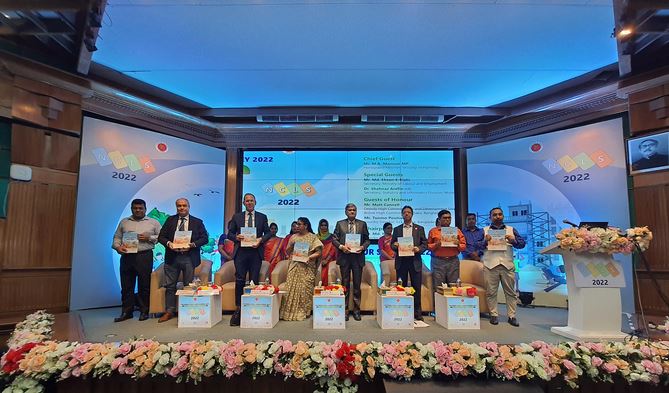
DHAKA, July 19, 2023 (BSS) - The number of children engaged in hazardous
child labour has declined significantly in the country as it has been
possible due to various initiatives taken by the government to eradicate
child labour from Bangladesh.
According to the provisional report of the National Child Labour Survey 2022
released today, the number of hazardous child labour in the country was
1,068,212 (2.7%) in 2022 which was 1,280,195 (3.2%) in 2013.
Bangladesh Bureau of Statistics (BBS) formally published the provisional
report on "National Child Labour Survey 2022 under "National Child Labour
Survey 2022" at a simple ceremony held at the auditorium of the BBS today.
Planning Minister MA Mannan spoke at the function as the chief guest while
Labour and Employment Secretary Md Ehsan-E-Elahi and Statistics and
Informatics Division Secretary Dr Shahnaz Arefin spoke as special guests.
Matt Cannell, Deputy High Commissioner and Development Director of the
British High Commission and Tuomo Poutiainen, Country Director, ILO, Dhaka,
Bangladesh spoke at the program as the guests of honour. Md Matiar Rahman,
Director General (Additional Secretary), BBS presided over the event while
Deputy Director General of BBS Parimol Chandra Basu gave the address of
welcome. Focal point of the survey and deputy director of BBS Saddam Hossain
Khan made a power-point presentation on the findings of the survey.
The objectives of the national child labour survey 2022 were to identify the
number of working children and children engaged in child labour and hazardous
child labour, to obtain information on the child population according to
various sectors, sexes, locations and households with children. Apart from
this, an idea about the educational attainment status of the child population
will be obtained.
Analyzing the results of the National Child Labor Survey 2022. It can be seen
that the number of children aged 5-17 years is 39,964,005 or 39.96 million.
Among them, the number of working children is 3,536,927 (8.9%) and children
engaged in child labour is 1,776,097 (4.4%), and hazardous child labour is
1,068,212 (2.7%) respectively.
Where the 2013 Child Labour Survey found that the number of children aged 5-
17 years was 39.652,384, among them working children was 3,450,369 (8.7%) and
children engaged in child labour was 1.698,894 (4.3%), and hazardous child
labour was 1,280,195 (3.2%).
A comparison of the results of the National Child Labor Survey 2013 and 2022
shows a slight increase in the number of working children and children
engaged in child labour in 2022 compared to 2013. This increase is
insignificant compared to the population growth in the last ten years.
Speaking on the occasion as the chief guest, the Planning Minister said that
the people of the country now wants development, drinking water, sanitation
and better school while the government has been working to ensure such
facilities.
Urging the countrymen to do their respective works properly and thus
contribute to the Nation building, Mannan said that it is the high time to
ensure optimum utilization of the demographic dividend that the country will
be enjoying till 2040.
Acknowledging the role of the development partners in the country's journey,
he said, "We want friends, but please let us continue to do our work on our
own,"
The Planning Minister also suggested the BBS to build up a strong database to
properly preserve its data.
Labour and Employment Secretary Md Ehsan-E-Elahi said that it was a matter of
satisfaction that the hazardous child labour has been declining in the
country.
He said that the Ministry of Labour and Employment in support of different
NGOs has been working to eliminate child labour in the country.
Ehsan informed that a Taka 2,500 crore project is being framed to eliminate
child labour in the country as well as to ensure their rehabilitation. He was
also hopeful of getting final approval of the project within three months.
"We'll be able to eliminate child labour in the country from all sectors," he
added.
Statistics and Informatics Division Secretary Dr Shahnaz Arefin said that day
is not so far when Bangladesh would be a 'child labour' free country with the
united efforts of all.
According to the latest NCLS 2022, 51.79% (20,698,077 or 20.70 million) are
male children, and remaining 48.21% (19.265,375 or 19.27 million) are female
children. The number of working children is 3,536,927 (3.54 million),
comprising 2,734,044 male children and 802,883 female children.
Male children are 1,374,154, and female children are 401,943 out of the
1.776.097 (1.77 million) children engaged in child labour. Similarly, out of
the 1,068.212 (1.07 million) children in hazardous child labour, the number
of male children is 895,195 (0.90 million), and the number of female children
is 173,017 (0.17 million), respectively.
Among 5-17 years old children, rural areas account for 30,349,052 or 30.35
million children and the urban regions account for 9,614,953 or 9.61 million.
The numbers of working children in rural and urban areas are 2,725.400 (9%),
and 811,527 (8.4%), respectively. Similarly, the number of children engaged
in child labour in rural areas is 1,337,464 (4.4%) and in urban areas are
438,634 (4.6%). In rural and urban areas, children involved in hazardous
child labour make up 832,693 (2.7%) and 235,519 (2.4%).
In terms of economic sectors, out of the total children aged 5-17 years,
1,079,559 or 1.08 million children are engaged in the agriculture sector,
1.191.806 or 1.19 million in the industry sector and 1,270,431 or 1.27
million children in the service sector respectively.
It is expected that the findings of this report will be pivotal for planners,
policymakers and other stakeholders in formulating policies to eliminate
child labour from Bangladesh by 2025. More details of this survey will be
available after the main report is published.